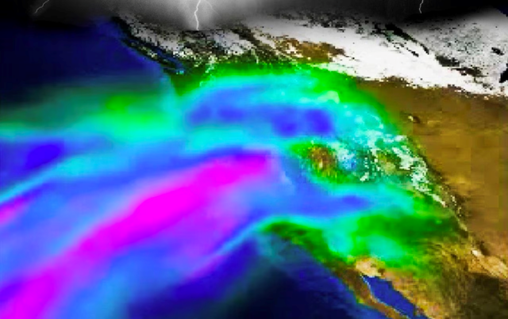By Emma Wu
What is an ARk Storm? This stands for “Atmospheric River 1,000 [k] Storm”. This is a hypothetical “megastorm” in California based on repeated historical occurrences of atmospheric rivers, major rain events, and flooding events in the region. This proposed scenario was first developed and published by the Multi Hazards Demonstration Project (MHDP) of the United States Geological Survey (USGS). There is the ARk Storm 1.0 and the ARk Storm 2.0, updated in 2022.
The ARk Storm 1.0 is a 2010 study, projecting an extreme storm over California that would devastate the area, causing up to $725 billion in damages and losses from flooding. There have been repeated circumstances of intense rain and flooding in past years. USGS sediment research in the San Francisco Bay Area, Santa Barbara Basin, Sacramento Valley, and the Klamath Mountain region have shown that megastorms have occurred in past years: 212, 440, 603, 1029, 1300, 1418, 1605, 1750, 1810, and, most recently, 1861-62. The intervals between these occurrences range from 50-426 years, for an historical average of 100-200 years between these events. The most intense storms were the ones in 440, 1418, 1605, and 1750, with the one in 1605 being the most intense to date. Each storm deposited a layer of silt more than 1 inch thick; in particular, the storm in 1605 left a layer of silt more than 2 inches thick, indicating that this storm was about 50% more powerful than any of the other ones recorded. With these projections, the ARk Storm 1.0 was projected to be significantly less intense than 25 days of rain, a storm that occurred between December 1861 and January 1862. This event dumped nearly 10 feet of rain in parts of California.
The conditions for such megastorms are as follows: “two super-strong atmospheric rivers, just four days apart, one in Northern California and one in Southern California, and one of them stalled for an extra day.” Atmospheric rivers are relatively long, narrow regions in the atmosphere, carrying water vapor through the sky. These rivers will concentrate large amounts of water vapor in specific areas, thus causing intense storms and flooding.
The ARk Storm 2.0 is the updated 2022 study, projecting a much more intense storm than originally anticipated by the ARk Storm 1.0. The conditions are held similar; however, with climate change models incorporated, the effects and intensity of the storm are much greater. Climate change is expected to increase the risk of severe flooding from the ARk Storm, as the runoff is predicted to be 200-400% greater than historic values of Sierra Nevada flooding (about 20 mm), which is nearly doubling with climate change and emission scenarios. The current models and flood maps, such as the FEMA maps, rarely take into account the projected ARk Storm and climate change models. FEMA maps are relied upon by land owners, flood insurers, media outlets, and governments, and these maps are not as up-to-date as they could be. These maps need to update with incorporation of new models, heavy rain events, and ever-updating studies regarding flood models. This will help everyone prepare for future situations, as drastic events, such as the ARk Storm, continue to be projected.










